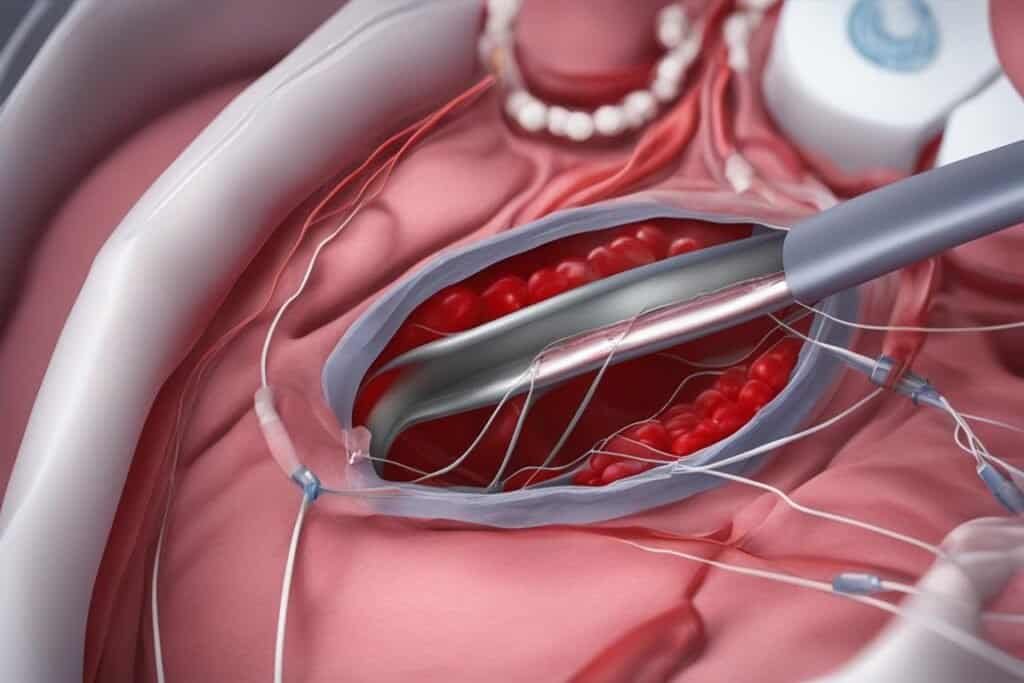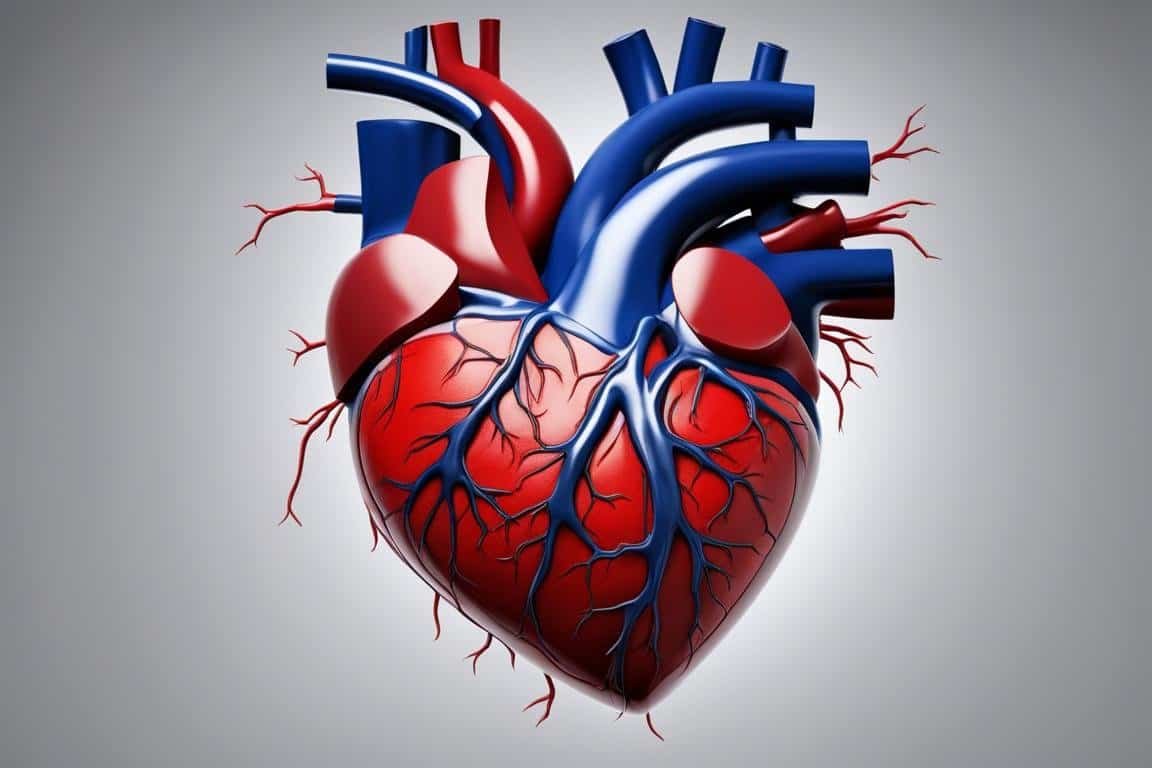When it comes to a heart attack, time is of the essence. Restoring blood flow to the heart quickly and effectively is crucial for minimizing damage to the heart muscle and improving recovery outcomes. As the saying goes, every second counts.
During a heart attack, a blockage in the arteries prevents oxygen-rich blood from reaching the heart. This can cause severe chest pain, shortness of breath, and even lead to life-threatening complications. Reperfusion therapy, which focuses on restoring blood flow, is the gold standard treatment for heart attacks.
Reperfusion therapy includes various treatment options such as stent insertion, angioplasty, and coronary artery bypass surgery. These procedures aim to open blocked arteries and restore blood flow to the heart. By doing so, they help minimize heart muscle damage and enhance the chances of successful heart attack recovery.
Immediate medical intervention, including the administration of appropriate medications like aspirin, clot busters, nitroglycerin, and beta blockers, is essential in managing the heart attack and improving blood flow. This combination of treatments and interventions works synergistically to save lives and promote better heart health.
Key Takeaways:
- Restoring blood flow promptly during a heart attack is crucial for minimizing heart muscle damage and improving recovery outcomes.
- Reperfusion therapy, including procedures like stent insertion, angioplasty, and coronary artery bypass surgery, is the standard treatment for heart attacks.
- Immediate medical intervention, including appropriate medications, plays a vital role in managing the heart attack and improving blood flow.
- Time is of the essence in treating a heart attack. Every second counts towards saving lives and promoting successful recovery.
- Seek medical help immediately if you suspect a heart attack. Early intervention can make a significant difference in the outcome.
Diagnosis and Tests for Heart Attack
Diagnosing a heart attack involves conducting several tests to confirm the condition and assess its severity. These tests include an electrocardiogram (ECG or EKG) that records the heart’s electrical signals and detects signs of a heart attack. Blood tests are performed to check for cardiac markers, specific heart proteins that are released when there is heart damage.
Other diagnostic tests such as a chest X-ray, echocardiogram, coronary catheterization (angiogram), and cardiac computed tomography (CT) or magnetic resonance imaging (MRI) may also be done to evaluate the heart’s structure, function, and blood flow.
These diagnostic tests help in confirming the presence of a heart attack and guiding the appropriate treatment.

Diagnostic Tests for Heart Attack
| Test | Purpose |
|---|---|
| Electrocardiogram (ECG or EKG) | Records heart’s electrical signals and detects heart attack signs |
| Blood Tests | Check for cardiac markers indicating heart damage |
| Chest X-ray | Evaluate heart’s structure and detect abnormalities |
| Echocardiogram | Assess heart’s function, including pumping strength and valve functionality |
| Coronary Catheterization (Angiogram) | Examine heart’s blood vessels to identify blockages |
| Cardiac Computed Tomography (CT) or Magnetic Resonance Imaging (MRI) | Provide detailed images of the heart to evaluate its structure and blood flow |
Medications for Heart Attack Treatment
During a heart attack, timely administration of appropriate medications is essential for restoring blood flow to the heart and minimizing damage. Below are some commonly prescribed medications used in the treatment of a heart attack:
- Aspirin: Aspirin helps reduce blood clotting and maintains blood flow through narrowed arteries, preventing further blockages.
- Clot busters: Also known as thrombolytics or fibrinolytics, these drugs break up blood clots that are blocking blood flow to the heart, reducing heart damage.
- Nitroglycerin: Nitroglycerin widens the blood vessels and improves blood flow to the heart, providing relief from sudden chest pain.
- Beta blockers: Beta blockers lower heart rate, decrease blood pressure, limit heart muscle damage, and reduce the risk of future heart attacks.
- ACE inhibitors: ACE inhibitors lower blood pressure, reduce stress on the heart, and improve overall heart health.
- Statins: Statins help lower unhealthy cholesterol levels, which can lead to artery blockages.
These medications are prescribed based on individual patient needs and may be combined to achieve the best results. It’s important to follow the doctor’s instructions regarding dosage and duration of medication use to ensure effective treatment.
Surgical and Interventional Procedures for Restoring Blood Flow
In addition to medications, surgical and interventional procedures play a crucial role in restoring blood flow to the heart during a heart attack. These procedures aim to quickly reopen blocked or narrowed arteries, ensuring that oxygen-rich blood reaches the heart muscle.
One commonly performed procedure is coronary angioplasty, also known as percutaneous coronary intervention (PCI). During this minimally invasive procedure, a catheter equipped with a deflated balloon is threaded through a blood vessel to the affected coronary artery. Once in position, the balloon is inflated, compressing the plaque and widening the artery. This improves blood flow to the heart, alleviates symptoms, and reduces the risk of further heart muscle damage.
To help maintain the newly opened artery and prevent re-narrowing, stent insertion often accompanies coronary angioplasty. A stent is a small wire mesh tube that is inserted into the artery to act as a scaffold, keeping it open and allowing blood to flow freely. This prevents the formation of new blockages and ensures long-term restoration of blood flow.
In more severe cases where multiple arteries are blocked or the disease is widespread, coronary artery bypass grafting (CABG) may be necessary. CABG is a surgical procedure in which a healthy blood vessel, typically taken from the chest, leg, or arm, is used to bypass the blocked or narrowed coronary artery. This creates an alternate route for blood to reach the heart muscle, restoring blood flow and preventing further damage.

Table:
| Procedure | Description |
|---|---|
| Coronary Angioplasty | A minimally invasive procedure in which a catheter is used to inflate a balloon and widen a blocked artery, improving blood flow to the heart. |
| Stent Insertion | A small wire mesh tube is inserted into the opened artery to keep it propped open, preventing re-narrowing and ensuring long-term blood flow restoration. |
| Coronary Artery Bypass Grafting (CABG) | A surgical procedure that involves using a healthy blood vessel from another part of the body to bypass the blocked or narrowed coronary artery, restoring blood flow to the heart. |
Following any of these procedures, cardiac rehabilitation is a crucial part of the recovery process. It involves a comprehensive program that combines exercise, education, and lifestyle modifications to help patients regain their strength, improve cardiovascular health, and gradually return to their normal activities.
Conclusion
Restoring blood flow to the heart during a heart attack is critical for minimizing damage and improving outcomes. Immediate medical intervention, including a combination of medications, surgical procedures, and cardiac rehabilitation, is essential in achieving this goal. However, preventing heart attacks is equally important and can be accomplished through a heart-healthy lifestyle.
Heart attack prevention begins with adopting healthy habits such as regular exercise, which helps strengthen the heart muscle and improve overall cardiovascular health. Engaging in physical activities like brisk walking, swimming, or cycling for at least 30 minutes a day can significantly reduce the risk of heart attacks. Additionally, maintaining a healthy diet low in saturated and trans fats, cholesterol, and sodium is vital. Incorporating plenty of fruits, vegetables, whole grains, lean proteins, and healthy fats like omega-3 fatty acids can promote heart health.
Smoking cessation is another crucial step in preventing heart attacks. Smoking damages the blood vessels, increases blood pressure, and reduces oxygen supply to the heart. By quitting smoking, individuals can dramatically reduce their risk of heart attacks and other cardiovascular diseases. Limiting alcohol consumption is also advisable, as excessive drinking can lead to high blood pressure and other heart-related problems.
Regular check-ups with healthcare professionals and cardiovascular risk assessments are vital in early detection and prevention. Regular check-ups allow for the monitoring of blood pressure, cholesterol levels, and overall heart health. By managing these risk factors, individuals can take proactive measures to prevent heart attacks and ensure the prompt and effective restoration of blood flow to the heart, if necessary.

